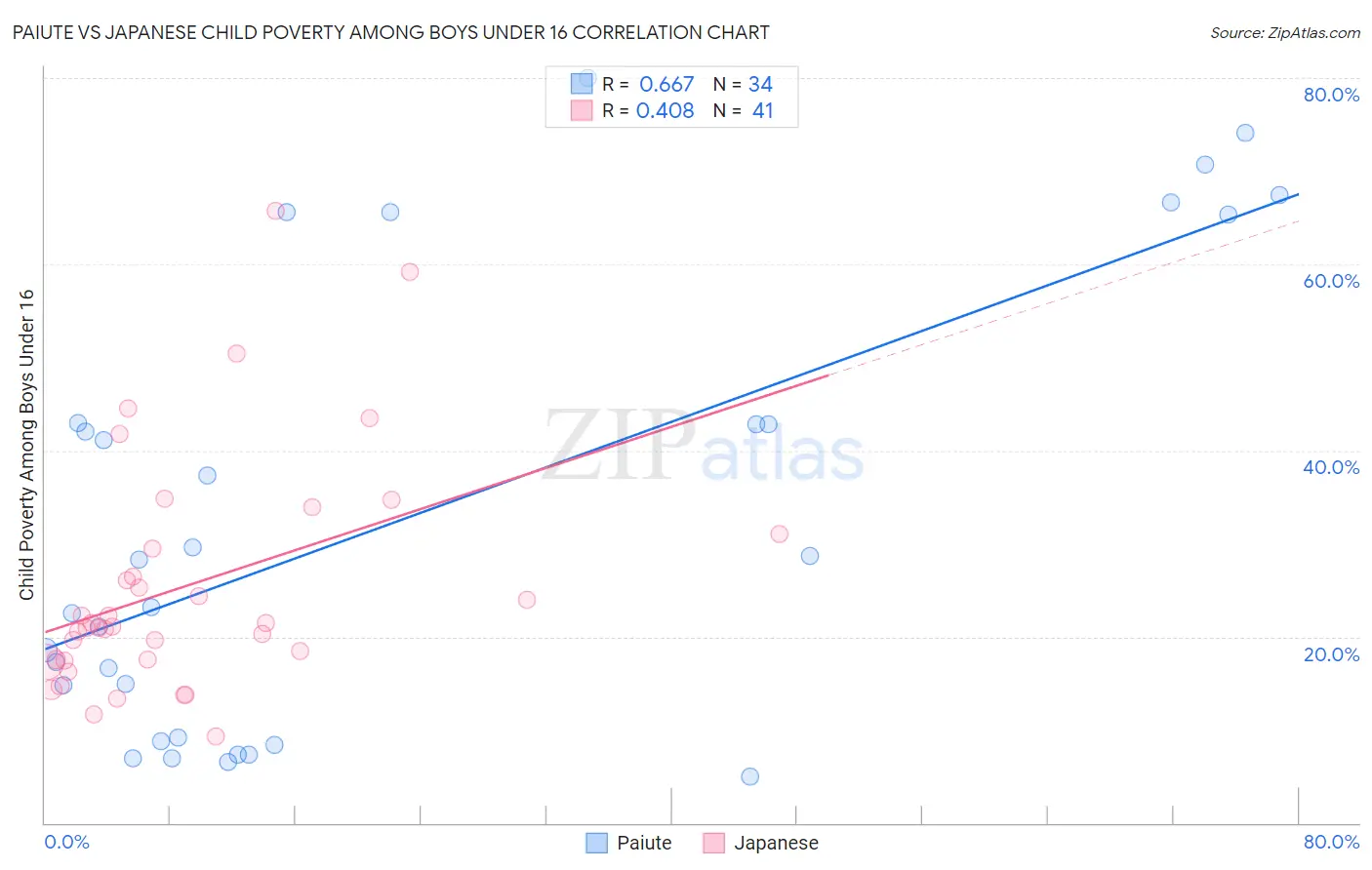Paiute vs Japanese Child Poverty Among Boys Under 16
COMPARE
Paiute
Japanese
Child Poverty Among Boys Under 16
Child Poverty Among Boys Under 16 Comparison
Paiute
Japanese
22.8%
CHILD POVERTY AMONG BOYS UNDER 16
0.0/ 100
METRIC RATING
326th/ 347
METRIC RANK
17.7%
CHILD POVERTY AMONG BOYS UNDER 16
5.5/ 100
METRIC RATING
217th/ 347
METRIC RANK
Paiute vs Japanese Child Poverty Among Boys Under 16 Correlation Chart
The statistical analysis conducted on geographies consisting of 58,198,272 people shows a significant positive correlation between the proportion of Paiute and poverty level among boys under the age of 16 in the United States with a correlation coefficient (R) of 0.667 and weighted average of 22.8%. Similarly, the statistical analysis conducted on geographies consisting of 247,557,395 people shows a moderate positive correlation between the proportion of Japanese and poverty level among boys under the age of 16 in the United States with a correlation coefficient (R) of 0.408 and weighted average of 17.7%, a difference of 28.4%.

Child Poverty Among Boys Under 16 Correlation Summary
| Measurement | Paiute | Japanese |
| Minimum | 4.9% | 9.3% |
| Maximum | 80.0% | 65.7% |
| Range | 75.1% | 56.4% |
| Mean | 32.5% | 25.4% |
| Median | 25.7% | 21.1% |
| Interquartile 25% (IQ1) | 9.2% | 17.5% |
| Interquartile 75% (IQ3) | 43.0% | 30.2% |
| Interquartile Range (IQR) | 33.8% | 12.7% |
| Standard Deviation (Sample) | 24.0% | 12.6% |
| Standard Deviation (Population) | 23.6% | 12.5% |
Similar Demographics by Child Poverty Among Boys Under 16
Demographics Similar to Paiute by Child Poverty Among Boys Under 16
In terms of child poverty among boys under 16, the demographic groups most similar to Paiute are Immigrants from Honduras (22.8%, a difference of 0.12%), Central American Indian (22.5%, a difference of 1.1%), Immigrants from Congo (22.4%, a difference of 1.7%), Honduran (22.3%, a difference of 2.0%), and Immigrants from Dominica (22.2%, a difference of 2.6%).
| Demographics | Rating | Rank | Child Poverty Among Boys Under 16 |
| Dutch West Indians | 0.0 /100 | #319 | Tragic 21.8% |
| U.S. Virgin Islanders | 0.0 /100 | #320 | Tragic 22.0% |
| Cajuns | 0.0 /100 | #321 | Tragic 22.2% |
| Immigrants | Dominica | 0.0 /100 | #322 | Tragic 22.2% |
| Hondurans | 0.0 /100 | #323 | Tragic 22.3% |
| Immigrants | Congo | 0.0 /100 | #324 | Tragic 22.4% |
| Central American Indians | 0.0 /100 | #325 | Tragic 22.5% |
| Paiute | 0.0 /100 | #326 | Tragic 22.8% |
| Immigrants | Honduras | 0.0 /100 | #327 | Tragic 22.8% |
| Pueblo | 0.0 /100 | #328 | Tragic 23.5% |
| Natives/Alaskans | 0.0 /100 | #329 | Tragic 24.0% |
| Colville | 0.0 /100 | #330 | Tragic 24.1% |
| Dominicans | 0.0 /100 | #331 | Tragic 24.2% |
| Immigrants | Dominican Republic | 0.0 /100 | #332 | Tragic 24.3% |
| Apache | 0.0 /100 | #333 | Tragic 24.5% |
Demographics Similar to Japanese by Child Poverty Among Boys Under 16
In terms of child poverty among boys under 16, the demographic groups most similar to Japanese are Iraqi (17.7%, a difference of 0.020%), Moroccan (17.7%, a difference of 0.030%), Sierra Leonean (17.8%, a difference of 0.10%), Osage (17.7%, a difference of 0.12%), and Panamanian (17.7%, a difference of 0.19%).
| Demographics | Rating | Rank | Child Poverty Among Boys Under 16 |
| Immigrants | Armenia | 6.8 /100 | #210 | Tragic 17.6% |
| Immigrants | Immigrants | 6.7 /100 | #211 | Tragic 17.6% |
| Aleuts | 6.6 /100 | #212 | Tragic 17.7% |
| Immigrants | Eastern Africa | 6.0 /100 | #213 | Tragic 17.7% |
| Panamanians | 5.9 /100 | #214 | Tragic 17.7% |
| Osage | 5.8 /100 | #215 | Tragic 17.7% |
| Moroccans | 5.6 /100 | #216 | Tragic 17.7% |
| Japanese | 5.5 /100 | #217 | Tragic 17.7% |
| Iraqis | 5.5 /100 | #218 | Tragic 17.7% |
| Sierra Leoneans | 5.3 /100 | #219 | Tragic 17.8% |
| Immigrants | Cambodia | 5.1 /100 | #220 | Tragic 17.8% |
| Immigrants | Panama | 4.3 /100 | #221 | Tragic 17.9% |
| Pennsylvania Germans | 3.9 /100 | #222 | Tragic 17.9% |
| Cubans | 3.8 /100 | #223 | Tragic 17.9% |
| Nepalese | 3.2 /100 | #224 | Tragic 18.0% |